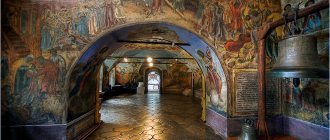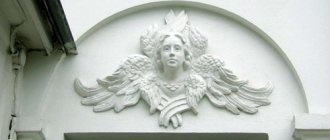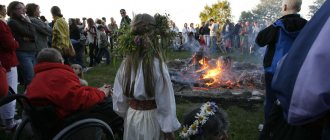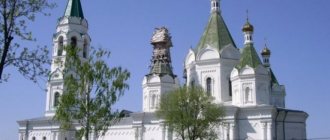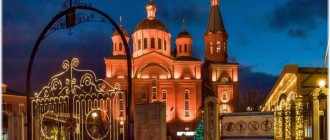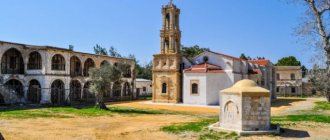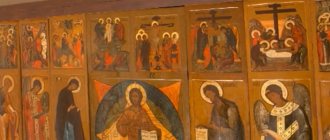Mir
Greece periphery Attica Monastery of Saints Cyprian and Justina Map is loading...
{"format":"leaflet","minzoom":false,"maxzoom":false,"limit":50,"offset":0,"link":"all","sort":[""], "order":[],"headers":"show","mainlabel":"","intro":"","outro":"","searchlabel":"\u2026 \u0441\u043b\u0435\ u0434\u0443\u044e\u0449\u0438\u0435 \u0440\u0435\u0437\u0443\u043b\u044c\u0442\u0430\u0442\u044b","default":"","import-annotation":false,"width ":"auto","height":"350px","centre":{"text":"","title":"""link":"""lat":38.11467180999999726509486208669841289520263671875,"lon": 23.67768287999999898829628364183008670806884765625,"icon":""},"title":"","label":"","icon":"","lines":[],"polygons":[],"circles":[ ],"rectangles":[],"copycoords":false,"static":false,"zoom":8,"defzoom":14,"layers":["OpenStreetMap"],"image layers":[] ,"overlays":[],"resizable":false,"fullscreen":true,"scrollwheelzoom":true,"cluster":false,"clustermaxzoom":9,"clusterzoomonclick":true,"clustermaxradius":80, "clusterspiderfy":true,"geojson":"","clicktarget":"","showtitle":true,"hidenamespace":false,"template":"","userparam":"","activeicon": "","pagelabel":false,"ajaxcoordproperty":"","ajaxquery":"","locations":[{"text":"\u003Cb\u003E\u003Ca href=\"/palomnik/%D0% 9C%D0%BE%D0%BD%D0%B0%D1%81%D1%82%D1%8B%D1%80%D1%8C_%D0%A1%D0%B2%D1%8F%D1%82% D1%8B%D1%85_%D0%9A%D0%B8%D0%BF%D1%80%D0%B8%D0%B0%D0%BD%D0%B0_%D0%B8_%D0%98%D1% 83%D1%81%D1%82%D0%B8%D0%BD%D1%8B\" title=\"\u041c\u043e\u043d\u0430\u0441\u0442\u044b\u0440\u044c \u0421\u0432\ " \u003E\u041c\u043e\u043d\ u0430\u0441\u0442\u044b\u0440\u044c \u0421\u0432\u044f\u0442\u044b\u0445 \u041a\u0438\u043f\u0440\u0438\u0430\u043d\u0430 \u 0438\u0418\u0443\u0441\u0442\ u0438\u043d\u044b\u003C/a\u003E\u003C/b\u003E\u003Chr /\u003E\u003Ca href=\»/palomnik/%D0%A1%D0%B2%D0%BE%D0%B9%D1% 81%D1%82%D0%B2%D0%BE:%D0%90%D0%BD%D0%BD%D0%BE%D1%82%D0%B0%D1%86%D0%B8%D1%8F \" title=\"\u0421\u0432\u043e\u0439\u0441\u0442\u0432\u043e:\u0410\u043d\u043d\u043e\u0442\u0430\u0446\u0438\u044f\"\u003E\u0410 \u043d\ u043d\u043e\u0442\u0430\u0446\u0438\u044f\u003C/a\u003E: "'\u041c\u043e\u043d\u0430\u0441\u0442\u044b\u0440\u044c\u0441\u04 32\u044f\u0442\u044b \u0445 \u043c\u0443\u0447\u0435\u043d\u0438\u043a\u043e\u0432 \u041a\u0438\u043f\u0440\u0438\u0430\u043d\u0430 \u0438 \u041 8\u0443\u0441\u0442\u0438\u043d \u044b»'\u00a0\u2014 \u043f\u0440\u0430\u0432\u043e\u0441\u043b\u0430\u0432\u043d\u044b\u0439 \u043c\u0443\u0436\u0441\u043 a\u043e\u0439\u043c\u043e \u043d\u0430\u0441\u0442\u044b\u0440\u044c, \u043e\u0441\u043d\u043e\u0432\u0430\u043d \u0432 1961","title":"\u041c\u043e\u043d\ u0430\u0441\ u0442\u044b\u0440\u044c \u0421\u0432\u044f\u0442\u044b\u0445 \u041a\u0438\u043f\u0440\u0438\u0430\u043d\u0430 \u0438 \u0418\ u0443\u0441\u0442\u0438\u043d\ u044b","link":"","lat":38.11467180999999726509486208669841289520263671875,"lon":23.67768287999999898829628364183008670806884765625,"ic on":""}],"imageLayers":[]}
38.028775; 23.757592
Greece, Attica periphery
periphery of Attica
Greece
Monastery of the Holy Martyrs Cyprian and Justina
- an Orthodox male monastery, founded in 1961, located in the suburbs of Fili and being the spiritual and administrative center of the Oropos and Fili Metropolis in the jurisdiction of the Old Calendar Orthodox Church of Greece (Synod of Chrysostomos).
Relics
Priests
In the Church of Saints Cyprian and Justinia, one of two priests is always on duty - Father Cyprian or Father Savvas, who also speak Russian. In general, it must be said that pilgrims from Russia are treated here with special love and warmth.
Relics of saints
In the center of the temple are the relics of Saints Cyprian and Justinia, near whom there is always a priest. If you suddenly don’t find him, just wait a little, he’ll come soon. Usually pilgrims approach the priest, he covers them with his epitrachelion (part of his vestment) and reads a prayer for them to Saints Cyprian and Justinia. After this, he takes bags of cotton wool dipped in olive oil from the box, blesses them on the relics and hands them over to the pilgrims. On the right side of the temple, on a stand in a box under glass, there is a “slipper” of St. Spyridon of Trimythous.
Icon of Saints Cyprian and Ustinia
To the right of the Royal Doors is the icon of Saints Cyprian and Ustinia. At the exit of their church of Saints Cyprian and Ustinia, on the left in the courtyard, pilgrims can draw water from a consecrated reservoir. In the temple courtyard you will see several water taps. Don't forget to bring an empty water bottle.
History[[edit]h2>
The monastery was founded in 1961 by Hieromonk Cyprian (Koutsoumbas) with the blessing of Elder Philotheus (Zervakos) in the suburb of Fili, in Attica, on the southwestern slope of Mount Parnipha, 20 km from the center of Athens.
Throughout the entire period of its existence, the monastery was the spiritual administrative center of the Greek Old Calendar jurisdiction “Synod of the Opposing,” and after the merger of the “Cyprian” and “Chrysostom” Synods, it became the spiritual and administrative center of the Oropos and Philian metropolis of the TOC of Greece (Synod of Chrysostom).
Ancient Temple
The Church of Saints Cyprian and Ustinha is one of the must-see places in Cyprus. We talk about the relics located in the temple, where the relics of Saints Cyprian and Ustinya are located, how to get there, about the schedule and coordinates of the church.
Story
There are a lot of blessed places in Cyprus, one of which is the Church of Cyprian and Ustinya - one of the most revered saints in Cyprus and in Orthodoxy in general. According to legend, Cyprian was a black magician who had direct communication with demonic forces. One day he was inflamed with love for the modest Ustinya, who was going to church to pray. After his long courtship, she set a condition for him to renounce magic. Seeing the strength of her faith, he was baptized and became an equally strong Christian ascetic.
Uniqueness
The Temple of Cyprian and Ustinha is several centuries old (according to historical documents, the first mention dates back to the 14th century) and is made in the architectural style traditional for Cypriot temples. Its special feature is the high bell tower, which as a landmark is visible from several kilometers away. The inside of the church looks very rich. Its walls and columns are filled with frescoes with the faces of saints. The entire space is illuminated by huge chandeliers. The temple is very quiet and cozy. Those who are tired or just want to retire can sit on the benches.
Temple architecture
The structure has a rectangular shape. The high walls are made of natural stone. The windows and doors are narrow and high. The two naves are connected in the shape of a cross. The roof has a complex configuration. It is covered with red tiles. The walls and domes are hand painted. Contemporary Cypriot artists worked on them.
Next to the church there are two shops with souvenirs dedicated to the history of the creation of the temple. You can also buy handmade icons there. The sellers in the shops speak Russian. Girls from Russia have been working there for more than eight years. They are happy to communicate with visitors, telling the history of the church and the miracles that happen there.
Road to the temple
How to get to the church from resort areas and the capital of the island? Coming from Nicosia on the A9 highway, follow the sign for the village of Palaiometocho. The next settlement along the route will be Meniko.
From Larnaca the village can be reached in 40 minutes by Intercity bus. Stop "Latsia". The journey by rented car will take less than half an hour.
From Limassol, take the B9 motorway to the intersection with the A9, where you turn right at the sign for Palaiometocho and continue to Meniko. From Paphos there is a road to Limassol (68 kilometers), and then a repeat of the previous route.
Memory of the saints. Cyprian and MC. Justina. Folk traditions
The people considered this day dangerous, when you need to be very attentive, careful, avoid quarrels and disputes: according to superstitious beliefs, the likelihood of meeting with “evil spirits” increased. But people have always understood that they should beware here, first of all, of sinners who do not believe in God, who often remember and call on the “devil.” They also said that those who are friends with the “green serpent” should be especially wary. After all, according to the definition of St. Basil the Great, “drunkenness is a self-willed demon,” and when we voluntarily betray ourselves into the hands of our enemies, we no longer dare to call on God’s help. On this day, pious people read a special prayer: men were supposed to pray to Saint Cyprian, and women were supposed to pray to Saint Justina.
